Charles I, 1625-1648
On the accession of Charles I., the farthing tokens were again proclaimed as lawful currency, and the counterfeiting
of them discouraged, and on the 11th of July, 1626, a patent was granted for seventeen years to the Dowager
Duchess of Richmond, and Sir Francis Crane. The first tokens of Charles I. resembled those of his father.
1. O. A crown over two sceptres in saltire. CARO. D. G. MAG. BRI. (or BRIT.
R. A harp crowned. FRA. ET. HIB. REX. Common.
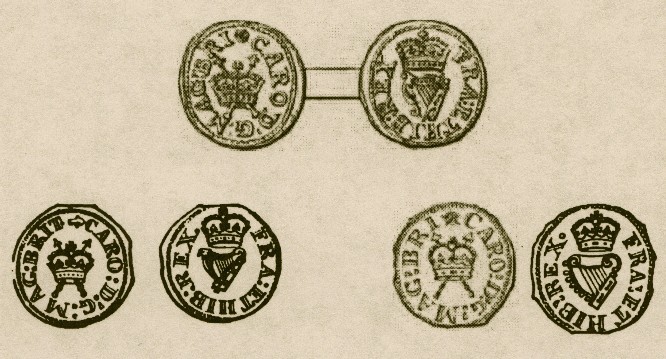
The mint marks appear on the obverse only, and the following occur:
[Unbarred A with bar across top]
Annulet
Ditto with pellet
Ditto surmounted by a cross
Ball
Battle-axe (two shapes)
Bell
Bell-shaped flower
Billet (heraldic)
Castle
Cinquefoil
Comet?
Crescent
Ditto with mullet
Cross of different shapes
Cross on steps
Cross fitchée
Cross fleury
Saltire cross |
Saltire cross, large and fleury
Crown
Dagger
Ermine spot
Eye
Fleur de lys
Two ditto
Three ditto
Fusil (sometimes two dots perpendicularly placed on each side)
Two ditto
Harp
Heart
Hook
Horse shoe (probably same as Omega)
Key
Key crowned |
Leaf
Leopard's head
Lion
Ditto rampant
Lozenge or mascle
Ditto with pellet
Martlet
Nautilus
Negro's head
Omega (Ω)
Pear
Quatrefoil
Rose (small and large)
Star
Star fish
Shield
Triangle
Tun
Trefoil
Woolpack
The figure 1 |
In my cabinet is an example with m. m. rose on the obverse only, but the crown on both sides is wide, flat and
double-arched as on No. 3, described hereafter. Mr. Caldecott has another example with the m. m. harp. On
another in my cabinet the m. m. cross appears on both sides, but as the word
REX in the reverse
legend appears as
RE, the m. m. on the reverse may have been inserted in error for the letter
X.
There are some few other mintmarks which are not capable of attribution to any defined object or symbol; but as
there were so many forgeries at this period these may be distorted representatives of some of the mint marks above
described. One variety reads CARA. and BRIT. m. m. rose, and I have seen
CARA. on another of these pieces, but these also may be forgeries of the period.
These tokens are sometimes found on square flans, and as strips of these have occurred (almost always with the
m. m. rose) it is most probable, as before stated when dealing with the similar tokens in the last reign, that they
were all struck on narrow strips of copper and cut out afterwards. A silver proof, reading BRI and
with m. m. cross occurs in the Imperial Collection at Vienna.
The shape of the harp differs on various coins. It is sometimes with the bird's head and sometimes without.
The next variety, which is much rarer, is generally more oval in shape, and the legend commences at the bottom,
preceded by the mint mark. The latter is sometimes placed between the stems of the sceptres. In other respects
this variety resembles the last.
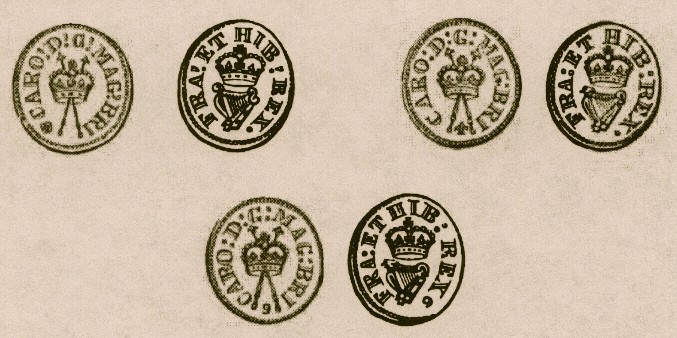
The following mint marks occur, generally on the obverse only, but sometimes on the reverse as well:
Cross patt&eaccute;e
Fret |
Rose
Small ditto and also the figure 9 (?) |
Fleur de lys
Three ditto |
I have only observed
BRI, and very rarely
BR, but never
BRIT on this
variety,
MA sometimes occurs instead of
MAG. A further variety, which may be
attributed to this series, reads Obv:
CAROLVS. D'. G'. MAG. BRI. A double arched crown with two
sceptres in saltire. The handles of the sceptres extend to the lower edge of the coin and enclose the m. m.
fleur de lys. Rev:
FRAN'. ET. HIB'. REX followed by the m. m. fleur de lys which has a pellet on either
side of it. A double arched crown surmounts a harp decorated with a bird's head. This piece is oval in shape, has
a beaded border on both sides, and weighs about 7 2/3 grains. It differs, but in very minor details, from the one
described in Snelling, Copp. Coinage, Section II., p. 5, Engraving
C.
Later in the reign an inner circle was adopted, and more care was exhibited in the workmanship. These tokens are
scarcer than those without the inner circle, but are not rare.
3. O. A crown over two sceptres in saltire. CAROLVS. D.G. MAG. BRIT. Inner circle.
R. A harp crowned. FRAN. ET. HIB. REX. Inner circle.
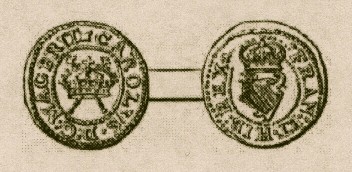
Bell
Cross |
Harp
Fleur de lys (large and small) and Woolpack. |
Martlet
Rose |
but the mint marks on this variety are not always the same on both sides of the coin; we have,
O. - Fret
O. - Harp
O. - Harp
O. - Fleur de lys
O. - Martlet
O. - Woolpack
O. - Woolpack |
R. - Fleur de lys
R. - Bell
R. - Woolpack
R. - Portcullis
R. - Bell
R. - Portcullis
R. - Rose |
In my collection is an example with m. m. woolpack on the obverse and no mint mark on the reverse.
In consequence of the gross abuses in connection with these tokens, and the facilities afforded thereby to
forgeries, a new farthing token, now sometimes called the rose or royal farthing, was issued in the year 1635.
It was coined in copper, but was sometimes composed of two metals, the more easily, as it was stated, to avoid
counterfeits. These pieces were thicker and heavier than the last, and a rose was substituted for the harp on the
reverse. There are three distinct types.
4. O. CAROLV. D. G. MA. (or MAG.) BR. (or BRI). A single arched
crown above two sceptres placed horizontally in saltire. Inner circle through which the ends of the sceptres pass.
R. FRA. ET. HIB. REX. A single rose surmounted by a single arched crown.
The only m. m. is that of a mullet on both sides. R. 5.
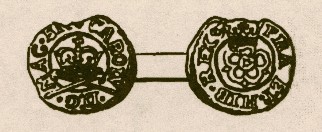
The second variety has the sceptres perpendicularly in saltire behind, and not under the crown, and reads -
5. O. CAROLVS. (or CAROLV.) D. G. MA. (or MAG.) BRIT.
(or BRI. or BR.)
R. FRAN. (or FR. or FRA.) ET HIB. (or HI.)
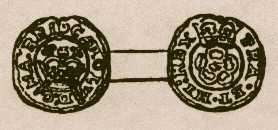
In other respects it resembles the last. The mint marks are as follows:
O. - Mullet
O. - Crescent
O. - Mullet
O. - Crescent
O. - Fleur de lys |
R. - Mullet
R. - Crescent
R. - Crescent
R. - Mullet
R. - Crescent |
In the National Collection is one of this type with m. m. crescent on the obverse, but no m. m. at all on the reverse,
and in the same collection is a specimen in silver with the lys mint mark, and which was, no doubt, a trial piece
intermediate between this and the next described variety. In some, the inner circle is more or less apparent, and this
has probably led to the belief that there is one variety in which the inner circle is wanting altogether.
6. The third variety has the name of CAROLVS at full length, and is of neater workmanship. This
variety has always the double rose, and the crown on both sides is double arched. The lettering is sometimes large
and sometimes small, and on one example belonging to Mr. Caldecott with the m. m. lys on the obverse, the reverse
reads FRAN'. ET. HIBE'. REX.

R. 3.
the mint marks occur on both sides and are,
| Fleur de lys |
Mullet |
Crescent |
In some, the m. m. on the obverse differs from that on the reverse. The following have been observed:
O. - Mullet
O. - Crescent
O. - Lys
O. - Mullet
O. - Lys |
R. - Crescent
R. - Mullet
R. - Mullet
R. - Lys
R. - Crescent |
I have a farthing of this variety which has no mint mark at all on either side, and there are two others, differing
in details, in the cabinet of Mr. Caldecott, one of which reads
HIBER; these are of very fine work
and somewhat suggestive of the style of Briot. A further example has the ordinary obverse m. m. lys and the reverse
of fine work reading
HIBER and with no m. m. There are specimens transitionary between the second and
third varieties, which have the obverse of the one and the reverse of the other.
In my cabinet (ex Coll. C. H. Nash) is a farthing of which an engraving is given below, and which is of very fine
workmanship, and different from any of the foregoing. It is probably a pattern. The rose is very large as is also
the crown surmounting it, and which latter is more than usually arched. The sceptres on the obverse are wholly
within the inner circle. The mint mark on both sides is a fleur de lys.
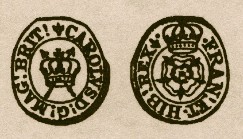
R. 3.
PATTERNS OF CHARLES I.
The first pattern that should be described is in silver, and does not, I believe, occur elsewhere than in the National
Collection. It resembles, but was evidently intended to be an improvement upon, the Harrington tokens.
1. O. CAROLVS. D. G. MAG. BRITANN. A double arched crown and the sceptres entirely within an inner circle.
No m. m.
R. FRAN. ET. HIBER. REX. The harp crowned within an inner circle through which the
crown penetrates. A small B (for Briot) after REX. R. 8.
Another pattern in copper resembling the later royal farthings is in the cabinet of Mr. Caldecott.
1A. O. CARO D'. G'. MA: BRI: A single arched crown.
R. FRA'. ET. HIB'. REX. Two sceptres in saltire. The sceptres have crowned heads and
rounded bases. There is a mint mark on both sides, but so rubbed as not to be able to be defined. Weight 15¾ grains.
Attempts were made to remedy the evils caused by the smallness and insignificant value of the tokens above referred to,
and several patterns have reached our time. The first of these is a piece about the size of the current farthing of
Charles II. It is of pure copper.
2. O. FARTHING. TOAKENS. (Snell: Copper Coins, Pl. 6, No. 1, wrongly spelt TOKENS). A crowned
rose over two sceptres in saltire. In each of the three lower angles made by the sceptres, a large fleur de lys.
R. TYPVS. MONETAE. ANGL. AERIS. A crown over two sceptres in saltire. In each of the three
lower angles, a lion passant to the left. R. 8.
This is most probably the work of Nicholas Briot, and of the same date as his pattern shilling bearing a similar inscription.
I know of only two examples, one in the National Collection, from the Devonshire Sale (Lot 296), and the other in my own,
from the Hollis, Durrant, Sparkes, and Brice Collections.
3. Mr. J. H. Burn, in his Introductory Memoranda to the London Tradesmen's Tokens, in the Beaufoy Cabinet, mentions
another pattern with the reverse from the same die as the last, but having on the obverse "CITTIE OF LONDON";
the device being a rose crowned between two swords, the points downward, and dated 1644. He asserts that this was in
the Devonshire Cabinet, and probably passed thence into the British Museum; but the Devonshire coin was of the above
described type 2. In the National Collection is certainly the CITTIE OF LONDON piece, which is probably
unique, and was purchased at the Trattle Sale (Lot 1526).
4. O. CAROLVS. D. G. M. B. REX. m. m. lys. A crowned rose between C. R. within an inner circle.
R. A. FARTHING. PLEDGE. Same as obverse, and with same mint mark. R. 6.
5. O. CAROLVS. D. G. MAG. BRIT. REX. The legend commences at the bottom of this coin. Within an inner
circle the king's bust in armour and with an ornamented helmet.
R. FRA. ET. HIBER. REX. The royal arms in an oval garnished shield within an inner circle
extending only round the lower half of the coin, within which is the legend. Before and after the latter is a rose.
The above coin is of the same size as the farthing tokens which bear the harp, and seems to have been a pattern for a
similar currency. There is a specimen in my own collection, and also in the National Collection.
6. A copper pattern of a larger size, which has been stated to be that of a coin, specimens of which exist in the
National Collection and in my own, has on both sides three crowns connected by a knot, but is without any legend. The
workmanship is fine, and the piece probably more of the nature of a jetton.
7. In the same collections also is a piece reading:
O. PRAY. FOR. THE. KING. The words separated by interlaced knots [quatrefoil-like figure]. In an
inner circle, a crowned rose between C. R.
R. LORD-GIVE THY-BLESING., in three lines. Above the word LORD and beneath the word
BLESING is an interlaced knot between two roses.
extending only round the lower half of the coin, within which is the legend. Before and after the latter is a rose.
It is possible that this piece also is a jetton struck on or after the execution of the king.
The following pieces are usually described as half groats, and are included in the series of silver coins, or rather
patterns for silver coins. Their weight, in silver, however, varies from 21 to 30 grains, and I prefer to treat them
as patterns for copper coins, particularly as two, at all events, occur in copper or brass. It may generally be
laid down as a rule that, when a coin, concerning which we have no direct information, occurs in two metals, the
lower metal most often represents its true position. Thus we have many proofs in silver, and sometimes in gold, of copper
coins; while proofs in silver of gold coins, and in copper of silver coins, rarely occur. There are, of course,
exceptions; but the comparative rarity of the coin in the one or the other metal has no bearing upon the question.
Silver specimens of Queen Elizabeth's "PLEDGE OF A PENNY" are far more common than copper ones. The
"QVATVOR MARIA VINDICO" farthings are more common in silver, and many other instance will occur
to the collector.
8. O. CAR. D. G. MAG. BRIT. FRAN. ET. HI. R. the king's bust bareheaded, with a ruff, m. m. lozenge.
R. FIDEI DEFENSOR. Two C's interlaced, surmounted by a crown; under the cyphers, a
small B. An inner circle on obv. and rev. R. 3. in silver, R. 8 in copper or brass.
This is by Briot, whose half-groat weighs 14 grains, whereas this, when in silver, weighs 27 or 28 grains. I have one
in brass in my collection which weighs 31 grains.
9. O. CAR. D. G. ANG. SCO. FR. ET. HIB. REX. Otherwise as No. 8.
R. Same as No. 8, but there is a lozenge under and on each side of the interlaced C's, and there is no
B under them.
I have seen this in silver only.
10. O. CAR. D. G. ANG. SCO. FR. ET. HIB. REX. m. m. a small lozenge. The king's profile bust with large ruff.
R. FLOREBIT. IN. AEVUM. A full-blown rose, irradiated, m. m. rose. R. 5.
A specimen of this in gold is in the National Collection. It otherwise occurs in silver only.
11. O. CAR. D. G. MAG. BRIT. FR. ET. HIBER. m. m. rose, king's head in profile with large ruff.
R. REGIT. VNVS. VTROQVE. m. m. rose, a sceptre and trident united by a triple knot
between a C. on each side, crowned. R. 5.
This also occurs in silver only. I have a specimen in my own collection of unusual thickness, weighing 54 grains. In
common with the above pieces it would appear to be the work of Nicholas Briot.
12. O. CAR. D. G. ANG. SCO. FR. ET. HIB. REX. Otherwise as No. 11.
R. As No. 11.
12A. O. As No. 10.
R. As No. 11.
Snelling also presents a coin (Patt: Gold and Silver Coins, Pl. 5, No. 27):
13. O. CAR. D. G. MAG. BRIT. FR. ET. HI. R. m. m. lozenge. C crowned in the field. Under
the C, and on both sides of it, is a small lozenge, though these do not appear in Snelling's plate.
R. Same as No. 10 and with the same m. m., but the rose is not irradiated.
This coin is in the National Collection, and is of some importance, as it is one-half the size of the ordinary piece,
and although it does not alter my own opinion it favours the arguments of those who would contend that the interlaced
C's on pattern No. 8. refer to the denomination of the pieces, and prove it to be a half-groat, in which
case the present pattern would represent a design for a penny.
I have lately secured an example of this type on which the rose is irradiated. Though somewhat rubbed, it weighs 15
grains, which is about the weight of the half-groat of that period.
14. O. A rose, surmounted by a large crown, and between C. R. both crowned. Under the rose is a small
B. for Briot.
R. A crowned thistle between C. R. both crowned. Under the thistle,
1640. Weight 23 grains R. 5 in silver, R. 8 in copper.
This also occurs in silver, but a specimen in copper is in the National Collection.
In my own collection is a silver pattern for a halfpenny, which has not been before (at all events, accurately)
described. It weighs 8 grains.
15. O. CAROLVS. REX. A full blown rose in an inner circle, crowned, between C. R.
R. A. HALF. PENI. Same design as on obverse. The m. m. is a small fleur de lys
on both sides. R. 7.
An example of the above piece occurred also in the Brice Collection.
There is one very similar to this represented in Snell. Patt. pl. 5, No. 19, but without C. R. on either
side, and reading A HALF PENNY. I have not been able to trace any such piece, which is probably a
blundered representation of the coin above described.
In the National Collection, and in mine also, is a silver pattern for a halfpenny, weighing 42 grains.
16. O. CAROLVS. D. G. MAG. BRIT. The king's head in profile to the left, crowned with a radiated
crown. After the inscription, which commences at the bottom, is a small B(?)
R. FRAN. ET. HIBER. REX. In the field is + C. ½D R.
surmounted by a large crown. R. 8.
This appears in Snell. Patt. Plate 5, No. 21, but the small B is omitted, and he refers to the coin
as being of mixed metal; mine is certainly of silver. He also expresses his opinion that, owing to the form of the
crown, which is unique, it was coined after the king's death; but this is more than doubtful. The weight of this
piece and of the others before described is important, as showing, with regard to patterns struck in metals other
than that of the intended current issue, that no fixed weight was employed, and this also indirectly proves that
these were all, with greater probability, patterns for a copper coinage.
I have another pattern in copper, a very worn example of which is also in the National Collection, and which I believe
does not occur elsewhere.
17. O. P. KING. ET. PARLIAMENT. The king's head in profile to the left, crowned. The king's hair is
long and curling, and falls over the shoulder.
R. A stem of rose and one of the thistle interlaced, surmounted by a small crown, which is
between the letters C. R. R. 8.
The inscription on this coin is singular. The P. probably stands for PRO. The weight
of the piece, which is extraordinarily thick, but not of larger module than the Briot pieces, is 102 grains.
In my cabinet is a copper piece of the size of a modern halfpenny; the obverse is plain but the reverse bears the
stems of a rose and thistle intertwined and crowned, similar in style and design to the last described coin, and
apparently by the same engraver.








